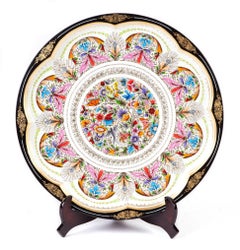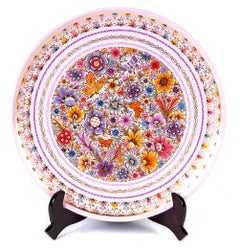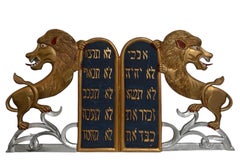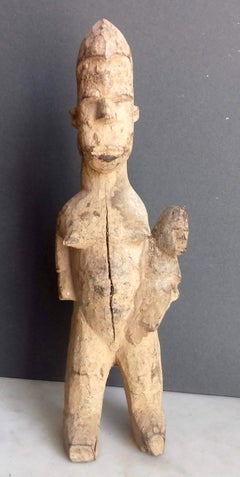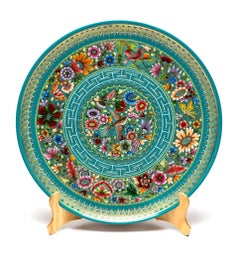Agustín Jorge Martínez Ramírez Mixed Media
to
2
Overall Width
to
2
2
2
2
295
265
150
148
Artist: Agustín Jorge Martínez Ramírez
Platon Blanco en Flor / Wood carving Lacquer Mexican Folk Art
By Agustín Jorge Martínez Ramírez
Located in Jesus del Monte, MX
FREE SHIPPING TO WORLDWIDE!
Artisan: Agustin Jorge Martinez Ramirez
IAM 2nd. Place Category “Gold Bathed Laca”
INSTITUTO DEL ARTESANO MICHOACANO LVII ...
Category
2010s Folk Art Agustín Jorge Martínez Ramírez Mixed Media
Materials
Lacquer, Wood
Platon Rosa con Flores / Wood carving Lacquer Mexican Folk Art
By Agustín Jorge Martínez Ramírez
Located in Jesus del Monte, MX
FREE SHIPPING TO WORLDWIDE!
Artisan: Agustin Jorge Martinez Ramirez
Fine wood pink plate, gold-platted with resin material. Decorated with flora and f...
Category
2010s Folk Art Agustín Jorge Martínez Ramírez Mixed Media
Materials
Wood, Lacquer
Related Items
Rare Folk Art Hebrew Judaica Carved Gilded Wood Lions Torah Synagogue Sculpture
Located in Surfside, FL
Paint and gold paint on wood
Circa early to mid 20th century.
This is not signed
A treasure from a proud congregation. It is a hand-carved wooden sculpture showing the Tablets of the Law flanked by two Lions of Judah. Their paws held the tablets. Their roaring mouths faced outward, protecting the commandments from threats. In a foliage design with gold and silver paint.
Circa 1920-1940's. This Neoclassical, Judaic, Art Deco, Egyptian revival, Shul, Aron Kodesh hand carving, wood with gilding, Hebrew lettering ten commandments sign sculpture, was produced probably in New York.
There was a show at the Folk Art Museum titled “Gilded Lions and Jeweled Horses: The Synagogue to the Carousel” That featured these antique magnificent pieces. From gilded lions to high-stepping horses, the sacred to the secular, and the Old World to the New, “Gilded Lions and Jeweled Horses: The Synagogue to the Carousel” traces the journey of Jewish woodcarvers and other artisans from Eastern and Central Europe to America and the unsung role they played in establishing a distinct Jewish culture in communities throughout the United States. The exuberant artworks stand as a testament to a history of survival and transformation and provide a surprising revelation of the link that was forged between the synagogue and the carousel as immigrant Jewish artists transferred symbolic visual elements into this vernacular American idiom. The first major study of this important aspect of the Jewish contribution to American folk art, the exhibition features approximately one hundred artworks and objects, including rare documentary photographs of Eastern European synagogue arks and carved gravestones, sacred carvings, papercuts, and carousel animals. Some of these same Jewish European carvers worked on Coney Island amusement park rides and carousel horses and other carnival and circus carvings.
Category
Early 20th Century Folk Art Agustín Jorge Martínez Ramírez Mixed Media
Materials
Metal
$3,600
H 20.25 in W 38 in D 1 in
African art tribal maternity figure, Lobi peoples Ghana - Ivory Coast
Located in Norwich, GB
A delightful African maternity figure from the Lobi peoples of the Ivory Coast/Ghana. With a serene yet feisty expression, the mother is carry...
Category
Mid-20th Century Folk Art Agustín Jorge Martínez Ramírez Mixed Media
Materials
Wood
$375
H 7.88 in W 2.76 in D 2.37 in
Edgy Dawn - Jan Coutts, Wildlife, blue, African, animals, zebra, rain, silver
By Jan Coutts
Located in Knowle Lane, Cranleigh
Edgy Dawn by Jan Coutts. A glimpse of two Zebra in a moment as they journey through the Savannah during the wet season in Africa. The wet season for zebras is a time of migration, bi...
Category
2010s Outsider Art Agustín Jorge Martínez Ramírez Mixed Media
Materials
Gold Leaf
$9,322
H 20.08 in W 24.02 in D 1.38 in
Wedding Chest of Corinne de Blaru, French 19th Century Folk Art Painted
Located in Cotignac, FR
Vintage French folk art, Early 19th century, painted wood wedding, hope or bridal chest, for the wedding of Charles Herbert Frederic and Corinne de Blaru in 1848. The names and dates...
Category
Early 19th Century Folk Art Agustín Jorge Martínez Ramírez Mixed Media
Materials
Iron
$2,130
H 11.03 in W 17.72 in D 11.82 in
"Windows", Contemporary Quilt
By Bethan Ash
Located in Brecon, Powys
This abstract art quilt has been created by using a collage technique Inspired by the patterns left on a windowpane after a shower of rain. Using salt resist on wet paint has created...
Category
2010s Folk Art Agustín Jorge Martínez Ramírez Mixed Media
Materials
Fabric
European 19th Century Folk Art Painted Wooden Hope, Bridal Wedding Chest
Located in Cotignac, FR
Early 19th century European folk art painted wood wedding, hope or bridal chest.
A superb example of a European hope or wedding chest in remarkable condition Of characteristic dome ...
Category
Early 19th Century Folk Art Agustín Jorge Martínez Ramírez Mixed Media
Materials
Iron
$2,130
H 11.03 in W 17.72 in D 11.82 in
UNTITLED (PAINTING ON WOOD)
By Purvis Young
Located in Aventura, FL
Original mixed media painting on wood.
Artwork is in excellent condition. Certificate of Authenticity included. All reasonable offers will be cons...
Category
Late 20th Century Outsider Art Agustín Jorge Martínez Ramírez Mixed Media
Materials
Wood, Mixed Media
Guatemala. Maschera di Baila de la Conquista. Inizio XX secolo
Located in Firenze, IT
Questa maschera guatemalteca del inizio del XX secolo, scolpita in legno e utilizzata per la danza della Riconquista (Baila de la Conquista) , raffigura vividamente un uomo europeo, ...
Category
Early 20th Century Folk Art Agustín Jorge Martínez Ramírez Mixed Media
Materials
Wood, Intaglio
$236 Sale Price
20% Off
H 7.49 in W 5.71 in D 4.34 in
Vintage wood face mask, dark brown
Located in San Diego, CA
Vintage wood mask. The edge undulates and is lightweight. Date and artist unknown.
Category
20th Century Folk Art Agustín Jorge Martínez Ramírez Mixed Media
Materials
Wood
Serengeti Trio -Jan Coutts, Cheetah, Wildlife, Gold, African, animals, Sprinting
By Jan Coutts
Located in Knowle Lane, Cranleigh
Serengeti Trio by Jan Coutts. A striking creation with mixed media including gold Leaf, depicts one of Coutts's most treasured subjects to paint - the Cheetah. The fastest land anima...
Category
2010s Outsider Art Agustín Jorge Martínez Ramírez Mixed Media
Materials
Gold Leaf
$5,298
H 10.04 in W 8.08 in D 1.97 in
"Wood Carving, " Wood Painted in Yellow, Red, Blue, & Green made in Indonesia
Located in Milwaukee, WI
This wood carving was created by an unknown Indonesian artist. It is approximately 17" tall by 7" wide. It was painted with abstract designs in primary colors.
Category
20th Century Folk Art Agustín Jorge Martínez Ramírez Mixed Media
Materials
Wood
Tree Of Life, Contemporary Quilt
By Bethan Ash
Located in Brecon, Powys
The inspiration for ’Tree Of Life’ came from a quilt I made for the ‘Quilt Art’ group exhibition ‘Moving On‘. The quilt was called ‘Black Hole’ (Mourning quilt) and describes the fee...
Category
2010s Folk Art Agustín Jorge Martínez Ramírez Mixed Media
Materials
Fabric
Previously Available Items
Plato Azul-Verde Perfilado en Oro / Wood carving Lacquer Mexican Folk Art
By Agustín Jorge Martínez Ramírez
Located in Jesus del Monte, MX
FREE SHIPPING TO WORLDWIDE!
Artisan: Agustin Jorge Martinez Ramirez
IAM 1st. Place Category “Gold Bathed Laca”
INSTITUTO DEL ARTESANO MICHOACANO XLVII...
Category
2010s Folk Art Agustín Jorge Martínez Ramírez Mixed Media
Materials
Wood, Lacquer
Agustín Jorge Martínez Ramírez mixed media for sale on 1stDibs.
Find a wide variety of authentic Agustín Jorge Martínez Ramírez mixed media available for sale on 1stDibs. You can also browse by medium to find art by Agustín Jorge Martínez Ramírez in lacquer, wood and more. Not every interior allows for large Agustín Jorge Martínez Ramírez mixed media, so small editions measuring 14 inches across are available. Customers who are interested in this artist might also find the work of Tom Carapic, Jodi Dann, and Bethan Ash. Agustín Jorge Martínez Ramírez mixed media prices can differ depending upon medium, time period and other attributes. On 1stDibs, the price for these items starts at $900 and tops out at $1,000, while the average work can sell for $950.
